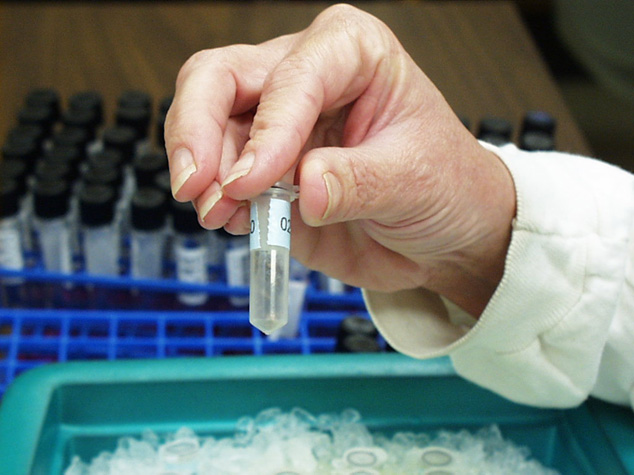Have you ever heard some scientific claim on radio or TV say something that made you stop and ask: “How do they do that?” Apparently this question bugged someone enough this week to call their extension agent and ask “How do you guys really know if a mosquito has west Nile virus?” I thought that was a pretty good question; and given the level of WNV testing going on right now in many Texas cities, it was one that deserved a public answer.

Monitoring mosquito-borne diseases has been an important part of military strategy for many years. Here an airman prepares a stink trap to catch Culex mosquitoes for testing. Photo courtesy Joint Base McGuire-Dix-Lakehurst, USAF.
You might wonder… Do they have veterinarians waiting in labs somewhere to take mosquito temperatures and read little mosquito pulses? Do we ask the mosquitoes, “How are you feeling today?” In reality, the whole process of mosquito testing is complex and pretty amazing. There are a number of steps involved, but first the mosquitoes have to be caught. To do this health officials use special traps that catch the mosquitoes that are most likely to be infected.
The most common mosquito traps for west Nile virus (WNV) use buckets of bacterial rich, highly stinky water as a lure. This is the kind of water that pregnant (gravid) female mosquitoes seek out for breeding. Stink traps typically have a little vacuum that sucks up the egg laying females and blows them into a lightweight sack for collection. Single mosquitoes are not commonly tested for WNV. Instead, a mosquito “pool” is a group of up to 50 mosquitoes taken from a single stink trap. Back in a lab, the mosquito pool is dumped into a vial with a little water and copper-coated bbs to give a little crushing power. The vial is shaken vigorously by a machine and presto! Mosquito juice! Mosquito juice is the starting point for all testing procedures. The juice of pulverized mosquitoes is rich in DNA, the genetic coding material that all life is based on. Thanks to amazing technological advances of the past 50 years, we can now amplify the minute amounts of DNA present in samples like mosquito juice, and determine what species it codes for. Also, if a mosquito is infected with a virus, we can look for specific RNA pieces that are unique to the virus we are interested in. If we find those pieces, we know we have infected mosquitoes.

The difference between healthy (left) and virus infected tissue culture cells. Photo courtesy Texas Department of State Health Services.
Before DNA testing is done, mosquito samples sent to the Texas Department of State Health Services will be run through a Vero cell culture. In this method mosquito juice is squeezed onto a specially prepared plate with a thin layer of living cells. After a few days of incubating the cells with the mosquito juice, a technician can look at the cells under magnification and determine if they look healthy. The presence of sick cells tells the technician that the mosquito pool carried one of several viruses that attack these cells. The health department prefers the Vero cell culture method because it is sensitive to many kinds of mosquito borne viruses. When a sample is positive for virus, then one of the molecular tests for specific virus RNA is run. These tests are highly specific, so that a test for WNV will not detect say St. Louis encephalitis (SLE) or chikungunya (CHIK), other important mosquito-borne diseases. Several tests will be run on any cell culture positive sample of mosquito juice. The problem with cell culture is that it’s expensive and takes several days to get results. Some cities are now using a faster method known as Real-time PCR. The results of a RT-PCR test can be returned sometimes as quickly as overnight. A WNV-specific RT-PCR test is less expensive and faster, however it is not sensitive to all mosquito borne diseases. The disadvantage is that it is highly specific for one kind of virus, so a health department looking for WNV without cell culture might miss a budding SLE or CHIK epidemic, for example. This kind of technology, by the way, is an example of a public benefit that can come from basic science. Before these tests could be invented, we had to know what mosquitoes carry disease and how to catch them, how RNA fingerprints of different viruses differ, how to multiply teeny amounts of DNA or RNA in mosquito juice so that it can be detected (a major advance of biotechnology in the 1980s), and how to build machines that can do these things quickly and inexpensively. A lot of research that seems academic eventually results in applications that can save human life. And that is pretty amazing.

